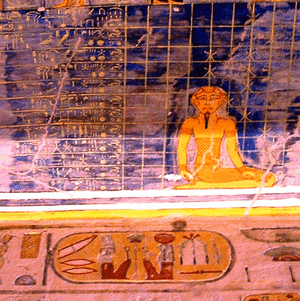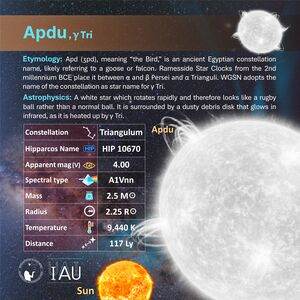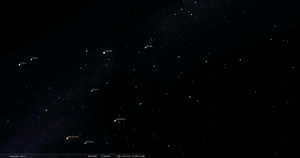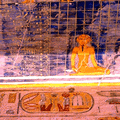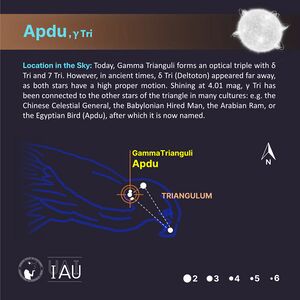Apdu: Difference between revisions
| (15 intermediate revisions by 3 users not shown) | |||
| Line 1: | Line 1: | ||
[[File:Ramses IX - fig6.gif|thumb|Detail of RSC in tomb of Ramses IX with Apdu (CC BY Juan Belmonte).]] |
|||
[[File:Apdu profileCard SadeghFaghanpour-IAU-WGSN.jpg|thumb|Apdu profile card (CC BY Sadegh Faghanpour for IAU-WGSN).]] |
|||
Apd(w), ''ȝpd'', The Bird, is an ancient Egyptian constellation. There are at least 21 spelling variants<ref>Bojowald, Stefan (2024). Überlegungen zu den Schreibungen des ägyptischen Wortes ȝpd „Vogel“, Équipe Égypte Nilotique et Méditerranéenne: [http://www.enim-egyptologie.fr/revue/2024/16/Bojowald_ENiM17_p267-272.swf.pdf PDF]</ref> throughout the millennia in hierglyphs, and it is probably not any specific one. |
Apd(w), ''ȝpd'', The Bird, is an ancient Egyptian constellation. There are at least 21 spelling variants<ref>Bojowald, Stefan (2024). Überlegungen zu den Schreibungen des ägyptischen Wortes ȝpd „Vogel“, Équipe Égypte Nilotique et Méditerranéenne: [http://www.enim-egyptologie.fr/revue/2024/16/Bojowald_ENiM17_p267-272.swf.pdf PDF]</ref> throughout the millennia in hierglyphs, and it is probably not any specific one. |
||
==Concordance, Etymology, History== |
==Concordance, Etymology, History== |
||
=== Origin of Constellation === |
=== Origin of Constellation === |
||
The constellation is mentioned in the Ramesside Star Clocks and identified by right ascension. Ramesside Star clocks (RSC) are astronomical devices developed in ancient Egypt to measure time by the, most likely, meridian or close to meridian transit of stars. These hour stars were single stars in a few cases or belong to constellations, some of them very large, of Egyptian sky maps. |
|||
| ⚫ | |||
The constellation is mentioned in the Ramesside Star Clocks and identified by right ascension. |
|||
There has been two dedicated approaches including an attempt to identify these hour stars: Leitz (1995)<ref name=":0">Leitz, Ch., 1995. Altägyptische Sternuhren. OLA, 62. Leuven: Peeters.</ref> and Belmonte (2003)<ref name=":1">Belmonte, J. A., 2003. The Ramesside star clocks and the ancient Egyptian constellations. In M. Blomberg, P. E. Blomberg and G. Henriksson (Eds.), ''Calendars, Symbols, and Orientations: Legacies of Astronomy in Culture'' (pp. 57–65). ''Uppsala Astronomical Observatory report'', 59. Uppsala Ocarina Books.</ref>. Pioneers Neugebauer and Parker (1969)<ref>Neugebauer, O. and Parker, R. A., 1969. ''Egyptian Astronomical Texts'', vol. III. Providence: Brown University.</ref> thought this was a worthless exercise. |
|||
Leitz (1995)<ref name=":0" /> followed N&P hypothesis of stars transiting close to the southern horizon and reached a solution which for Belmonte (2003) was not satisfactory for varios motives. These are amply discussed in Lull and Belmonte (2006 & 2009)<ref name=":2">Belmonte, J.A. andd Lull, J., 2023. Astronomy in ancient Egypt: a cultural perspective. Cham: Springer. </ref>. This new hypothesis suggests that several RSC constellations were located in the northern skies such as the Giant (Nekht), the She-Hippo (Reret), the Mooring Post (Menyt) and the Bird (Apdu), among others of lesser entity (see also Davies, 1985<ref>Davis, V. L., 1985. Identifying Ancient Egyptian Constellations. ''Journal of the History of Astronomy'', ''16'', 102–104.</ref>). The constellation Bird could be the one represented in the northern sector of several celestial diagrams. |
|||
Belmonte first defended his ideas at SEAC2001 in Stockholm (Belmonte, 2003)<ref name=":1" /> that were later used for posterior works such as Belmonte and Lull (2023)<ref>Belmonte, J.A. andd Lull, J., 2023. Astronomy in ancient Egypt: a cultural perspective. Cham: Springer. </ref>. |
|||
Among these hypotheses, it was proposed to locate the 4 stars of the Ramesside Star clocks located in the constellation Apd (Apdu) in Triangulum and close to Algol (proposal recently endorsed by Belmonte and Lull, 2023)<ref name=":2" />. Pegasus is far in RA. |
|||
Belmonte (2003)<ref name=":1" /> proposal was, considering the corresponding RA: |
|||
| ⚫ | |||
| ⚫ | |||
!Egyptian |
|||
! |
|||
!Translation |
|||
| ⚫ | |||
| ⚫ | |||
|b'nt nt apd |
|||
|Banat net Apdu |
|||
|(the Peak of the Bird) |
|||
|Alpha Tri ([[Mothallah|Mothalla]]) |
|||
| ⚫ | |||
|tp n apd |
|||
|Tep en Apdu |
|||
|(the Head of the Bird) |
|||
|Beta Tri |
|||
| ⚫ | |||
|htyt nt apd |
|||
|Hetyt net Apdu |
|||
|(the Throat of the Bird) |
|||
|A star in the area of [[Algol]] |
|||
| ⚫ | |||
|kft=f |
|||
| ⚫ | |||
|Its rump (of the Bird) |
|||
|Alpha Per ([[Mirfak]]) |
|||
| ⚫ | |||
Being imaginative and avoiding interference with the stars in the Ramesside tables, which were probably the brightest in the constellation, we may even suggest for γ Tri a name of something certainly located in the head of Apdu, for example the Eye (the peak is already another hour-star). |
|||
==== Spelling Variants ==== |
==== Spelling Variants ==== |
||
| Line 12: | Line 51: | ||
*Apdu |
*Apdu |
||
*Apd(w) |
*Apd(w) |
||
[[File:Stellarium ApduBird.gif|thumb|Apdu bird as falcon (like the one depicted in the tomb of Sethy I in the King's Valley) mapped to Stellarium]] |
|||
==== Identifications ==== |
==== Identifications ==== |
||
| Line 22: | Line 62: | ||
=== Sources, Transfer and Transformation of the Constellation === |
=== Sources, Transfer and Transformation of the Constellation === |
||
There is no identification of this constellation in Neugebauer and Parker, or in Leitz (1995), as their works focussed on the so-called decan-constellation (further south). <gallery> |
|||
Here we give a list of all sources where the name is attested. |
|||
File:Tumba de Ramsés V y de Ramsés VI, Valle de las Reyes, Luxor, Egipto, 2022-04-03, DD 69.jpg|Tombs of Ramses V and VI (Diego Delso). |
|||
| ⚫ | |||
| ⚫ | File:Lepsius-228-III-ramsèsVI-détail.jpg|schema of a Ramesside Star Clock (Fonctionnement d'une horloge ramesside.) from Karl Richard Lepsius - Denkmäler aus Ägypten und Äthiopien: Nach den Zeichnungen der von Seiner Majestät dem Könige von Preussen Friedrich Wilhelm IV nach diesen Ländern gesendeten und in den Jahren 1842-1845 ausgeführten wissenschaftlichen Expedition. |
||
| ⚫ | |||
File:Culmination-horloge-ramesside.jpg|explanation of Ramesside Star Clock by Frank Monnier |
|||
!Source |
|||
File:The tomb of Seti I 6.jpg|Tomb of Sethy I - front (CC BY Leon Petrosyan) |
|||
| ⚫ | |||
File:Ramses IX - fig6.gif|Tomb of Ramses IX with a RSC, detail photograph by J. Belmonte. |
|||
| ⚫ | |||
</gallery> |
|||
| ⚫ | |||
| ⚫ | |||
| ⚫ | |||
| |
|||
| |
|||
| ⚫ | |||
| |
|||
| |
|||
| ⚫ | |||
== Religion/ Mythology == |
== Religion/ Mythology == |
||
| Line 42: | Line 74: | ||
== IAU Working Group on Star Names == |
== IAU Working Group on Star Names == |
||
[[File:Apdu stickfigure SadeghFaghanpour-IAU-WGSN (1).jpg|thumb|Apdu stickfigure (CC BY Sadegh Faghanpour for IAU-WGSN)]] |
|||
Irtentapdu (for the eye of the bird, γ Tri) was proposed as a star name in 2023/5 in WGSN. Egyptian language does not spell all letters; in Irt-nt-Apd(w) some vowels can be added for easier pronounciation. |
|||
Alpha and Beta Trianguli are already named but Gamma is not. Apdu is the name of a constellation so it is not appropriate for a single star. Considering RA, γ Tri could have served as an hour-star as well as β Tri (similar RA) and possibly formed part of the head of the Bird "Tep en Apdu" which could be a good name for it but this can cause confusion with β Tri. Hence, Irt-nt-apd(w) or "Iret net Apdu", the Eye of the Bird, would describe the position of γ Tri. Irtentapdu (for the eye of the bird, γ Tri) was proposed as a star name in 2023/5 in WGSN. Egyptian language does not spell all letters; in Irt-nt-Apd(w) some vowels can be added for easier pronounciation. |
|||
In November 2025, WGSN decided to adopt the name of the attested constellation "Apdu" rather than an invented star name within this ancient constellation. The name was adopted for γ Tri (Gamma Trianguli) as proposed. |
|||
γ Tri is a bright (V=4.0 mag) star of type A0Vn (Abt 1995) at distance of approximately 36 parsecs. [https://ui.adsabs.harvard.edu/abs/2012A%26A...537A.120Z/abstract Zorec & Royer (2012)] estimate the star to have an effective temperature of 9940 K, luminosity of about 32x that of the Sun, radius of 2.11 Rsun, mass 2.26 Msun, projected rotational velocity (vsini) 254 km/s, and age of 407+-39 million years. Fetherolf+ (2023) detects variability with period 0.450848 day in TESS photometric data, consistent with rotation. Combining the radius calculated from the Zorec and adopting the rotation period from Fetherolf, this would suggest an equatorial rotation velocity of about 236 km/s, similar to the vsini value. This suggests that the star is seen equator-on. The star also has a dusty debris disk detected by the IRAS, Spitzer, and WISE missions (e.g., [https://ui.adsabs.harvard.edu/abs/2014ApJS..211...25C/abstract Chen et al. 2014, ApJS], 268, 4). All of its properties, including its color, equatorial rotational velocity, and even its dusty debris disk, make the star very similar to Vega, except Vega is seen nearly pole-on, and γ Tri is apparently seen nearly equator-on. |
|||
== Weblinks == |
== Weblinks == |
||
| Line 55: | Line 92: | ||
[[Category:Africa]] [[Category:Egyptian]] |
[[Category:Africa]] [[Category:Egyptian]] |
||
[[Category:Asterism]] [[Category:Constellation]] |
[[Category:Asterism]] [[Category:Constellation]] |
||
[[Category:IAU-Star Name]] |
|||
[[Category:Tri]][[Category:Per]] |
|||
Latest revision as of 16:56, 17 November 2025
Apd(w), ȝpd, The Bird, is an ancient Egyptian constellation. There are at least 21 spelling variants[1] throughout the millennia in hierglyphs, and it is probably not any specific one.
Concordance, Etymology, History
Origin of Constellation
The constellation is mentioned in the Ramesside Star Clocks and identified by right ascension. Ramesside Star clocks (RSC) are astronomical devices developed in ancient Egypt to measure time by the, most likely, meridian or close to meridian transit of stars. These hour stars were single stars in a few cases or belong to constellations, some of them very large, of Egyptian sky maps.
There has been two dedicated approaches including an attempt to identify these hour stars: Leitz (1995)[2] and Belmonte (2003)[3]. Pioneers Neugebauer and Parker (1969)[4] thought this was a worthless exercise.
Leitz (1995)[2] followed N&P hypothesis of stars transiting close to the southern horizon and reached a solution which for Belmonte (2003) was not satisfactory for varios motives. These are amply discussed in Lull and Belmonte (2006 & 2009)[5]. This new hypothesis suggests that several RSC constellations were located in the northern skies such as the Giant (Nekht), the She-Hippo (Reret), the Mooring Post (Menyt) and the Bird (Apdu), among others of lesser entity (see also Davies, 1985[6]). The constellation Bird could be the one represented in the northern sector of several celestial diagrams.
Belmonte first defended his ideas at SEAC2001 in Stockholm (Belmonte, 2003)[3] that were later used for posterior works such as Belmonte and Lull (2023)[7].
Among these hypotheses, it was proposed to locate the 4 stars of the Ramesside Star clocks located in the constellation Apd (Apdu) in Triangulum and close to Algol (proposal recently endorsed by Belmonte and Lull, 2023)[5]. Pegasus is far in RA.
Belmonte (2003)[3] proposal was, considering the corresponding RA:
| Egyptian | Translation | Identification[5] | |
|---|---|---|---|
| b'nt nt apd | Banat net Apdu | (the Peak of the Bird) | Alpha Tri (Mothalla) |
| tp n apd | Tep en Apdu | (the Head of the Bird) | Beta Tri |
| htyt nt apd | Hetyt net Apdu | (the Throat of the Bird) | A star in the area of Algol |
| kft=f | Its rump (of the Bird) | Alpha Per (Mirfak) |
Being imaginative and avoiding interference with the stars in the Ramesside tables, which were probably the brightest in the constellation, we may even suggest for γ Tri a name of something certainly located in the head of Apdu, for example the Eye (the peak is already another hour-star).
Spelling Variants
- Apedu
- Apdu
- Apd(w)
Identifications
The area of The Bird must cover a region in Triangulum and close to Algol. Belmonte and Lull (2011) proposed the following identifications:
- (a) Banat net Apdu (the Peak of the Bird) - α Tri
- (b) Tep en Apdu (the Head of the Bird) - β Tri
- (c) Hetyt net Apdu (The Throat of the Bird) - a star close to Algol
- (d) Iret net Apdu (the Eye of the Bird) - γ Tri
Sources, Transfer and Transformation of the Constellation
There is no identification of this constellation in Neugebauer and Parker, or in Leitz (1995), as their works focussed on the so-called decan-constellation (further south).
schema of a Ramesside Star Clock (Fonctionnement d'une horloge ramesside.) from Karl Richard Lepsius - Denkmäler aus Ägypten und Äthiopien: Nach den Zeichnungen der von Seiner Majestät dem Könige von Preussen Friedrich Wilhelm IV nach diesen Ländern gesendeten und in den Jahren 1842-1845 ausgeführten wissenschaftlichen Expedition.
Religion/ Mythology
mnemonic tales and cultural significance
IAU Working Group on Star Names
Alpha and Beta Trianguli are already named but Gamma is not. Apdu is the name of a constellation so it is not appropriate for a single star. Considering RA, γ Tri could have served as an hour-star as well as β Tri (similar RA) and possibly formed part of the head of the Bird "Tep en Apdu" which could be a good name for it but this can cause confusion with β Tri. Hence, Irt-nt-apd(w) or "Iret net Apdu", the Eye of the Bird, would describe the position of γ Tri. Irtentapdu (for the eye of the bird, γ Tri) was proposed as a star name in 2023/5 in WGSN. Egyptian language does not spell all letters; in Irt-nt-Apd(w) some vowels can be added for easier pronounciation.
In November 2025, WGSN decided to adopt the name of the attested constellation "Apdu" rather than an invented star name within this ancient constellation. The name was adopted for γ Tri (Gamma Trianguli) as proposed.
γ Tri is a bright (V=4.0 mag) star of type A0Vn (Abt 1995) at distance of approximately 36 parsecs. Zorec & Royer (2012) estimate the star to have an effective temperature of 9940 K, luminosity of about 32x that of the Sun, radius of 2.11 Rsun, mass 2.26 Msun, projected rotational velocity (vsini) 254 km/s, and age of 407+-39 million years. Fetherolf+ (2023) detects variability with period 0.450848 day in TESS photometric data, consistent with rotation. Combining the radius calculated from the Zorec and adopting the rotation period from Fetherolf, this would suggest an equatorial rotation velocity of about 236 km/s, similar to the vsini value. This suggests that the star is seen equator-on. The star also has a dusty debris disk detected by the IRAS, Spitzer, and WISE missions (e.g., Chen et al. 2014, ApJS, 268, 4). All of its properties, including its color, equatorial rotational velocity, and even its dusty debris disk, make the star very similar to Vega, except Vega is seen nearly pole-on, and γ Tri is apparently seen nearly equator-on.
Weblinks
References
- References (general)
- ↑ Bojowald, Stefan (2024). Überlegungen zu den Schreibungen des ägyptischen Wortes ȝpd „Vogel“, Équipe Égypte Nilotique et Méditerranéenne: PDF
- ↑ 2.0 2.1 Leitz, Ch., 1995. Altägyptische Sternuhren. OLA, 62. Leuven: Peeters.
- ↑ 3.0 3.1 3.2 Belmonte, J. A., 2003. The Ramesside star clocks and the ancient Egyptian constellations. In M. Blomberg, P. E. Blomberg and G. Henriksson (Eds.), Calendars, Symbols, and Orientations: Legacies of Astronomy in Culture (pp. 57–65). Uppsala Astronomical Observatory report, 59. Uppsala Ocarina Books.
- ↑ Neugebauer, O. and Parker, R. A., 1969. Egyptian Astronomical Texts, vol. III. Providence: Brown University.
- ↑ 5.0 5.1 5.2 Belmonte, J.A. andd Lull, J., 2023. Astronomy in ancient Egypt: a cultural perspective. Cham: Springer.
- ↑ Davis, V. L., 1985. Identifying Ancient Egyptian Constellations. Journal of the History of Astronomy, 16, 102–104.
- ↑ Belmonte, J.A. andd Lull, J., 2023. Astronomy in ancient Egypt: a cultural perspective. Cham: Springer.
